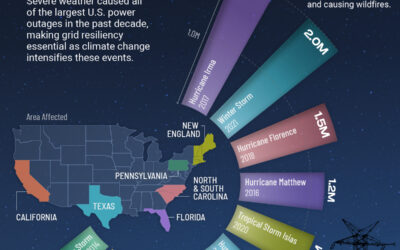
How Does the Power Grid Work?
Electricity is critical to our daily lives, but how does it get from the power plant to our homes?
The power grid is a complex interconnected system that powers the entire economy by carrying electricity from the source of generation and delivering it to our homes, offices, and factories. Sometimes referred to as “the world’s largest machine”, the grid is an important engineering marvel for the modern economy.
The above infographic from the National Public Utilities Council explains how the power grid works and highlights the three key components that make up the grid.
#1: Electricity Generation
The grid begins with power plants that generate electricity, typically owned and operated by public, private, or investor-owned utilities.
More than 11,000 power plants comprise the U.S. grid, generating over 4 trillion kilowatt-hours (kWh) of electricity annually. These are fueled by various energy sources:

Natural gas and coal together accounted for 60% of annual electricity generation in 2021, followed by nuclear power. Wind was the largest renewable energy source, making up 10% of renewable electricity generation.
Each power generation technology has a different role to play in the larger power grid. For example, coal and nuclear power plants that cannot easily adjust their output are known as baseload power plants. Their output remains roughly the same throughout the day, and they are typically used to deliver the minimum amount of power needed to keep the grid running.
On the other hand, power generation from natural gas and intermittent renewable sources like wind and solar fluctuates throughout the day, typically peaking in the evenings when demand is at its highest. Natural gas plants are especially useful in meeting peaks in demand because their output can be adjusted relatively quickly.
#2: Transmission
After generation, electricity travels from power plants to centers of demand through a process known as transmission.
First, the electricity is sent from power plants to substations where step-up transformers convert it to extremely high voltages for transmission. High-voltage conversions help minimize how much electricity is lost as heat during transmission, which is roughly 5% in the United States. The higher the voltage, the less electricity is lost.
Transmission lines then carry this high-voltage electricity across long distances and are often interconnected across states. Line voltages can vary from 69,000 volts (69 kV) to 765kV, and transmission lines can be both overhead and underground.
Here’s a map of all high-voltage (345kV or greater) U.S. transmission lines:

Source: U.S. Energy Atlas
Upgrading and expanding transmission infrastructure is key to achieving a decarbonized power grid, especially as utilities build solar and wind capacity in the sunniest and windiest parts of the country.
#3: Distribution and Consumption
Distribution is the final stage of delivering electricity, making up the last major component of the grid.
Simply put, distribution begins when transmission ends. It is the process of transporting power from the transmission system to individual customers. First, step-down transformers convert the high-voltage power from transmission lines into lower voltages that are suitable for use.
These transformers are connected to distribution poles, which are typically made of wood and used to carry electricity within centers of demand. There are about 180 million distribution poles in the U.S., and it’s likely that you encounter one every day, especially if you live in a city.
Distribution lines and poles deliver electricity to end consumers including households, office buildings, factories, and electric vehicles. Here’s a look at U.S. electricity sales to each end-use sector in 2021:

Source: EIA
Heating and cooling are the largest residential electricity uses. In the commercial sector, refrigeration and computers and office equipment account for over a quarter of electricity use. The transportation sector is by far the smallest electricity consumer, but these figures may change as electric vehicle sales rise.
At all times, the amount of electricity sent through the grid must match demand from end-use sectors. This is because all grids operate at a particular frequency (60 hertz in the United States). Excess power supply or demand can destabilize this frequency, potentially damaging grid infrastructure and triggering blackouts.
Modernizing the Power Grid
Just like machines that get old and need greasing, the U.S. power grid is aging and it needs an upgrade, especially as the power sector works to achieve 100% clean electricity by 2035.
The demand for electricity could accelerate in a scenario with high electrification, which involves switching from fossil fuel-powered technologies to electrical ones. For instance, one form of electrification is switching from gas-powered cars to electric cars.
To meet the growing demand for electricity, especially from clean energy sources, the U.S. will need to expand its transmission capacity and invest in modernizing the grid. In fact, reaching 100% clean electricity by 2035 could require anywhere from $330 billion to $740 billion in additional power system expenditures, according to a study by NREL.
Ultimately, upgrading and decarbonizing the grid are both pivotal to the U.S.’ climate goals, and this requires action from all stakeholders, from electric utilities to the government and end consumers.
The National Public Utilities Council is a collaborative body of industry experts coming together to solve decarbonization challenges in the power sector and the proud sponsor of the Decarbonization Channel.




